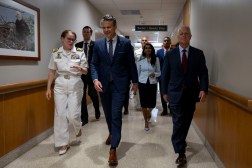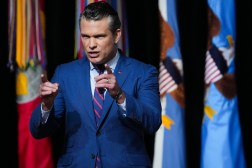DOD civilians could soon see more opportunities for cash awards, other performance incentives

New guidance issued Tuesday by Pentagon leadership is intended to spur Defense Department components to expand the use of civilian workforce incentives and awards for high performers and personnel with in-demand skill sets.
In a memo to top DOD officials, Undersecretary of Defense for Personnel and Readiness Anthony Tata issued instructions for retaining and rewarding “top talent.”
“Effective immediately, the Secretaries of the Military Departments, the Chairman of the Joint Chiefs of Staff, and the heads of all other DoW Components are expected to utilize all available authorities to strategically retain, reward, and recognize high-performing civilian employees, particularly those in critical skill areas essential to mission readiness,” Tata wrote, using an acronym to refer to the Department of War.
The Trump administration recently rebranded the Defense Department as the War Department.
“Where DoW Component policy is more restrictive than DoW policy, the Component should consider removing such limitations (e.g., Quality Step Increase timing). To ensure the Department is attracting, incentivizing, and retaining top talent, the Military Departments and other Do W Components should fully utilize available awards and incentives to target employees who make the greatest contributions to the Department’s mission. Factors to consider when developing targeted measures include demonstrated superior performance, unique technical expertise, and performance of the most critical and hard-to-fill roles,” Tata added.
DOD component heads should consider “maximum participation” in existing award incentives, he wrote, including cash awards up to 20 percent of basic pay, Quality Step Increases for outstanding employees, Special Act or Service Awards for significant contributions or innovations, and Time Off Awards up to 80 hours per year for “superior accomplishments.”
Authorization from component heads is not required to approve individual cash awards greater than $10,000 and up to $25,000, Tata noted, adding that they’ll be allowed to delegate authority to recognize “exceptional civilian contributions.”
DOD components may also approve civilian workers for the student loan repayment program for amounts up to $10,000 annually in any calendar year — with a lifetime cap of $60,000. Additionally, department components “may approve recruitment, relocation, and retention incentives up to 25 percent of basic pay per year (up to 100 percent in total over multiple years); up to 50 percent with Office of Personnel Management approval for a critical agency need,” Tata wrote.
The Pentagon is competing with the private sector for talent, including people with cyber, AI and aviation know-how, among other areas. Tata’s memo did not identify specific skill sets that will be prioritized for civilian workforce incentives.
The use of incentives to facilitate retention will be shaped by determinations about whether particular employees are likely to leave federal service, based on “multiple risk level factors including market trends and projections,” Tata noted.
Within 45 days of the date of the issuance of Tata’s memorandum, DOD components are tasked with submitting a plan of action and milestones. Progress reports are expected within 90 days.
They’ve also been directed to review existing budgetary resources available for civilian personnel incentives; identify and address funding shortfalls; incorporate incentive funding into the Program Objective Memorandum cycle and multi-year planning; and develop “internal controls to monitor expenditures, ensure audit readiness, and promote transparency,” to ensure appropriate use of funds.
Officials in Tata’s office plan to assess whether current authorities are sufficient and come up proposals within 60 days for legislative, regulatory and policy changes that would be helpful.
“The Department’s civilian workforce is foundational to mission success and national security. Now is the time to act boldly to ensure we are recruiting, retaining and rewarding those whose service most strengthens the Department and supports the warfighter,” Tata wrote.
Tata’s guidance was released on the same day that Defense Secretary Pete Hegseth hosted a rare gathering of hundreds of generals and admirals at Marine Corps Base Quantico and released a slew of new directives.
“My priority as Secretary of War is restoring the warrior ethos. This applies to every member of the Department, including our highly skilled civilian employees, who are oftentimes paid less than their private sector equivalents. These employees provide critical continuity in support of our Service members and act as force multipliers in defending this great Nation,” Hegseth wrote in a memo to Pentagon leadership on Tuesday regarding modern workforce management.
“We recently surveyed our civilian workforce. We heard loud and clear that personnel policies must better reflect our high-performance culture. This requires reforming how we treat both top and bottom performers. Winning organizations optimize the workforce spectrum,” he added, noting that high performers should be rewarded, and managers need more guidance on how to “separate underperforming employees.”
The new push to retain high performers and workers with in-demand skill sets comes after the Trump administration cut DOD’s civilian workforce by more than 60,000 employees via the Deferred Resignation Program, Voluntary Early Retirement Authority offerings and other options.






